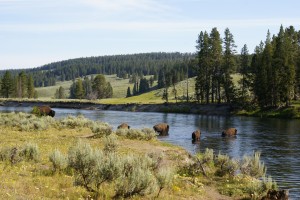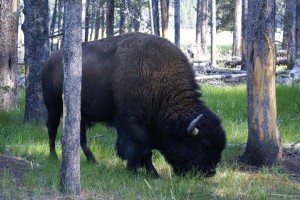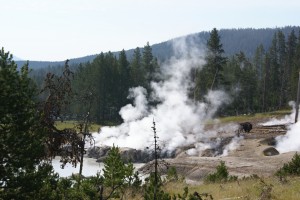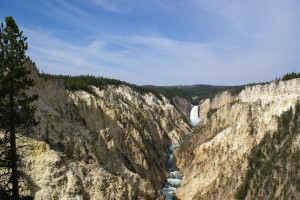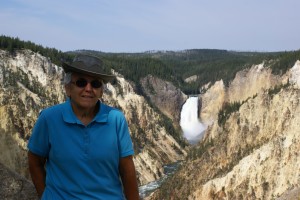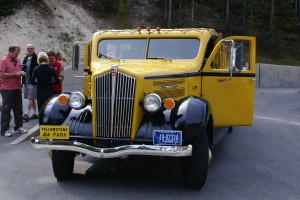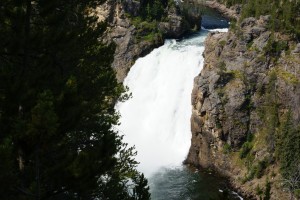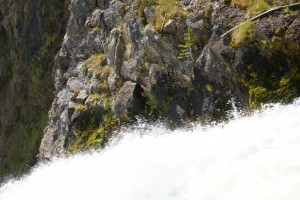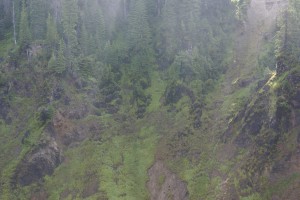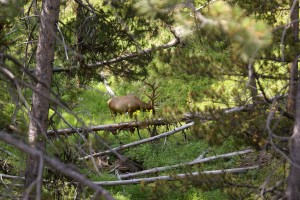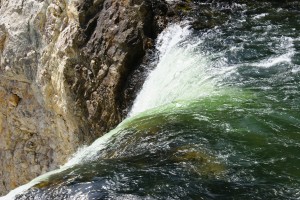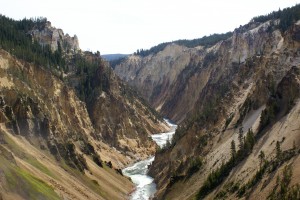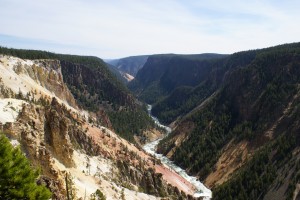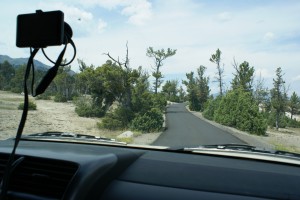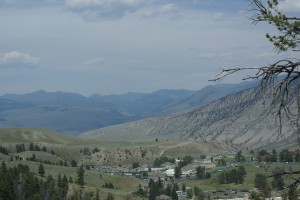We had a long day yesterday and decided to get an earlier start today. We left at 7:08 AM and headed for the East Entrance to Yellowstone N. P. We enjoyed the drive up to and into the Park as much as we had the day before. As with yesterday’s post, I can’t possibly describe and illustrate a day in YNP, so I will outline our itinerary, comment on a couple of things, and include a few photos.
Coming in from the East Entrance we again passed through Fishing Bridge, making a brief stop there to top off the tank, clean the windshield (yes, YNP has bugs, though not that many), and use the facilities. (Note: there are restrooms at every major feature in the Park with a parking lot.) After crossing the bridge we headed north up the west side of the Yellowstone River towards the Yellowstone Falls and The Grand Canyon of the Yellowstone and Canyon Village beyond.
On the way up we encountered Bison crossing the Yellowstone River. I had a nice chat with the fisherman they “chased” out of the river. He was fishing for Cutthroat Trout (catch and release only) at spot known as “Buffalo Ford” so it did come as any surprise to him when Buffalo showed up and forded the river.
Bison are common in YNP. They are usually slow moving and docile looking, but look into their eye(s) and you are looking into a wild animal. Massive and prone to agitate for no apparent reason, they are much more dangerous than people seem to realize, and close encounters with people generally do not end well for the person.
The area between Fishing Bridge and Tower-Roosevelt, along the Yellowstone River and into the massive upland wilderness to the east, is a prime spot in the park for large wildlife. Ravens are everywhere in the park, and other birds, including pelicans, are often seen. But this Yellowstone River area includes Trumpeter Swans, mule deer, blacktail deer, bison, elk, moose, coyotes, wolves, black bears, and the king of the wilderness, Grizzly bears. Seeing bison is guaranteed, and probably deer as well. Elk are a rarer sight, but catching even a glimpse of a wolf or bear is truly special. Before reaching the Falls we stopped at Mud Volcano, where bison were roaming through the geothermal landscape.
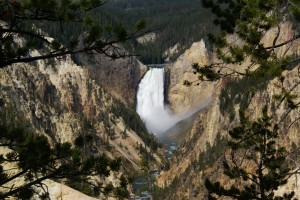
The Lower Falls of the Yellowstone River from Artist Point on the south/east side of Yellowstone Canyon.
The Yellowstone Falls and Grand Canyon of the Yellowstone are iconic features of the park, and worth taking time to see. The falls face northeast, and the canyon runs that direction as well, so morning is the time to be there, and we were. We drove into both the south/east rim (Artist Point) and north/west rim roads (brink hikes) and drove to Inspiration Point. I will let the photographs do the talking.
From the Falls/Canyon it is a short drive north to Canyon Village. The Canyon Village Visitor Information Center is Fabulous. We had a light lunch of salad and mandarin oranges at the lodge cafeteria before continuing on our tour of the northern half of the Grand Loop. We decided to do this loop clockwise, and headed over to Norris Geyser Basin. This is a large geothermal area and requires a lot of hiking to see all of the features. By this point it was getting hot and we were a bit tired, so we viewed what we could from platforms near the museum building. When you only have a couple of days to spend in YNP, there will come a point when you realize you can’t begin to see everything, and resolve to come back, perhaps many times. We reached that point at Norris.
As we left Norris and headed north towards Mammoth Hot Springs we paralleled the Gallatin Range to our west. We skipped most of the features until we got near Mammoth Hot Springs, and took the Upper Terrace Drive. This area is different from the other geothermal places in YNP, with travertine as the distinguishing visual element. It is much less active than it was when I was here 50 years ago, a result of the constant earthquakes that alter the geothermal activity all over the park.
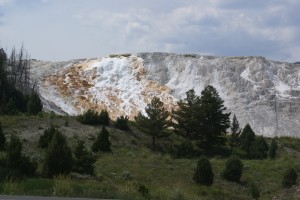
Travertine in the Upper Terraces area. The travertine is white; the color comes from living organisms.
Mammoth Hot Springs is five miles from the North Entrance at the Montana border and the famous Roosevelt Arch, but we did not drive up on this trip; so much park, so little time. We drove through Mammoth Hot Springs and saw Old Fort Yellowstone from the car. Every developed area in YNP has a different look and feel, and MHS is a place we will spend more time the next time we are here.
We continued our clockwise journey going east towards Tower-Roosevelt. We took the Blacktail Plateau Drive, a 6-mile long, narrow, twisty dirt road with lots of steep up and down grade and significant elevation change, although 4-wheel drive is not required. We saw a pair of Blacktail Deer with good size antlers lying in the shade of a distant tree. And we did not see any other cars until we got near the end of the road. Most tourists do not venture onto these little side roads so they give you a very different experience of the park from the Grand Loop.
We returned to the Grand Loop Road and headed trough Tower-Roosevelt for Canyon Village. The Northeast Entrance road, which runs from Tower-Roosevelt to Silver Gate and Cooke City, is the longest and most remote in the park. When the road leaves YNP it becomes the Beartooth Highway (US-212), one of the highest and most remote highways in the lower 48 states. Our plans for tomorrow are to drive part of this highway in conjunction with the Chief Joseph Scenic Byway.
As soon as we left Tower-Roosevelt we got caught in a construction stoppage that lasted 30 minutes. The road from Tower-Roosevelt back down to Canyon Village is a bit narrower and climbs past 10,243 ft Mount Washburn, the highest mountain in the Washburn Range, and over 8,859 ft. Dunraven pass. We had a nice drive as afternoon turned to early evening until we got south of Canyon Village, where once again, we encountered a massive traffic jam in the area of the broad river plain where the bison hang out. This time it wasn’t a bear sighting. The bison were in the road and the Park Rangers were using their vehicles and PA systems to herd them off. Some of them went reluctantly. Once past the traffic jam, we made our way to Fishing Bridge and from there out of the park by way of the East Entrance and back to Wapiti.
